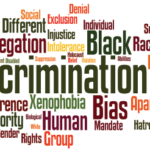2020 has not only borne witness to a global pandemic, but also to increasing fervor in the fight for racial equity. In a wave of opposition to the systemic racism in the U.S., people have been in the streets demonstrating and protesting against social injustice and have taken to social media to promote political action. Like the civil rights movement of the 1960s and the riots in L.A. after the death of Rodney King, the protests that ensued after George Floyd was killed by police have increased the urgency of attaining racial equity in this country.
Like many organizations, the ACR issued a statement after Mr. Floyd was killed to condemn “all acts that cause marginalization, discrimination, harm or death to any person.” This statement touched on documented health disparities, such as in lupus mortality and arthritis disability among minorities with rheumatic disease. These disparities are symptoms of systemic racism in the U.S. and in the field of medicine.
That systemic racism exists in medicine is not to say a large percentage of healthcare providers are racist. In fact, systemic racism doesn’t rely on the presence of people who are racist. Rather, this brand of racism is often unintentional and results from established—and unquestioned—policies, procedures and workflows.

Irene Blanco, MD, MS
“We need to move away from the definition of racism as an individual interaction between two people. It’s not, necessarily,” says Irene Blanco, MD, MS, professor of medicine, associate dean of diversity enhancement, and rheumatology fellowship program director at Albert Einstein College of Medicine, The Bronx, N.Y. “We need to think of racism much more as a system of oppression that is much wider and grandiose than any one individual person.”
The consequence of systemic racism in medicine is health disparities among minority patients (e.g., in lupus and arthritis). These disparities are compounded by systemic racism in other facets of society, such as in access to healthcare and health insurance, housing and segregation, socioeconomic status, and the criminal justice system.

Ashira Blazer, MD, MSCI
“It is important to remember that because medicine is an institution in America where multiple layers of systemic racism exist, it’s difficult not to have systemic racism in medicine,” says Ashira Blazer, MD, MSCI, assistant professor of medicine in the Division of Rheumatology at NYU Langone Health. “Whenever certain groups of people are disenfranchised, … those same groups end up being either inadvertently or outright discriminated against by the ways that we practice medicine.”
Addressing systemic racism in medicine is complex, but the first step is recognizing that it exists and being willing to talk about it. When the conversation is approached openly, honestly and with good intentions, real change is possible.
How Racism Hurts Patients
Racism contributes to a range of adverse health outcomes and health inequities for minorities.1 Specifically, rates of disease and death—including earlier onset and faster progression—are higher among African Americans, Native Americans, native Hawaiians and other Pacific Islanders, and Hispanic immigrants, even after adjusting for socioeconomic status. Further, racism is associated with poorer mental health, including depression, anxiety and psychological stress, and discrimination increases the risk of hypertension among African Americans.2,3
Access to care—or lack thereof—is a significant driver of adverse outcomes among minority patients, explains Randy Vince Jr., MD, in a perspective piece published in JAMA. He recalls his own medical education, being one of five Black students in a class of 120, and listening to a professor blame tumor biology for the poorer outcomes among Black men with prostate cancer.4
“No one comes into healthcare saying, ‘I’m going to serve care with a side of racism today.’ We come in because we want to hold up the Hippocratic oath; we want to heal; we want to serve; we want to make people better; we want to be able to help to make our communities & societies better. Where we fail from oath to practice is that we do not remove barriers to systems & implement educational opportunities, so I can learn about the people who I’m serving.” —Dr. Rose
Health disparities in America cannot be explained by biology, Dr. Vince writes, citing Unequal Treatment: Confronting Racial and Ethnic Disparities in Health Care.5 The Institute of Medicine report states that racial and ethnic minorities receive lower quality of care and experience worse outcomes than white patients. These disparities remain today, as demonstrated by the COVID-19 pandemic’s disparate rates of SARS-CoV-2 infections and mortality among minority groups.6-8
Higher infection rates and other health disparities are symptoms of a bigger issue—namely, the structural factors (e.g., access to health insurance) that influence the health of the population.9 In fact, Black people and other racial minorities are less likely than white people to have insurance.10
Implicit bias also plays a role in disparate health outcomes. Everyone has implicit biases—subconscious attitudes, stereotypes and assumptions that can affect actions. Provider bias is correlated with biased treatment recommendations for Black patients and worse communication, including nonverbal cues from the provider.1,11
A striking example of health disparities in rheumatology is in systemic lupus erythematosus (SLE) and lupus nephritis, which disproportionately affect African Americans. One cohort study of nearly 21,000 individuals with end-stage renal disease (ESRD) due to lupus nephritis showed an overall decrease in mortality of 11.1 deaths per 100 patient-years to 6.7 deaths per 100 patient-years when comparing 1995–1999 with 2010–2014, but African American patients had worse outcomes than white patients in both time periods.12
One hypothesis for this disparity is socioeconomic status. Researchers looked at this correlation among more than 42,000 Medicaid patients and found mortality rates were 21% higher among Black patients and 40% higher for Native Americans than among white patients after adjusting for cardiovascular and other comorbidities.13
Patients who are discriminated against or who experience racism in their lives have worse outcomes, too. Results from the Black Women’s Experiences Living with Lupus (BeWELL) study illustrate this, showing that increasing frequency of racial discrimination was associated with greater SLE activity and organ damage.14 Further results from BeWELL show that indirect or vicarious exposure to racism—that is, hearing about or observing acts of racism or discrimination—is also associated with greater disease activity.15

Connor D. Martz, MS
“Racism-related stress, such as direct or indirect experiences of racial discrimination, may partially explain why Black women with SLE experience more rapid disease progression than white women,” says Connor D. Martz, MS, a doctoral candidate in human development and family studies at Auburn University, Alabama, and collaborator on the BeWELL study. “Studies have shown Black women with SLE who report higher levels of racial discrimination experience increased disease activity and irreversible organ damage.”
The correlation between racism-related stress and disease flares is obvious, Dr. Blazer says. “Black women with lupus have been telling us, forever, that when they become stressed out, they have lupus flares. As a profession, we could believe them,” she says.
In her research, Dr. Blazer is interested in “identifying where the discrimination meets the biology.” The “strange, bittersweet part of it,” she says, is that the research to validate this experience needs to be done at all.
Make a Difference
There’s no doubt it’s going to take dedication and hard work to address systemic racism in America’s medical institutions and practices. With a focus on improving systems, rheumatologists and rheumatology professionals can achieve wins in medicine like those seen when the civil rights policies of the 1960s resulted in positive health effects or the housing improvement programs in New York and other cities bolstered community health.1,16
Clinicians should ask themselves, “How do I work against this system, slowly but surely, little by little, piece by piece, with myself and my trainees and my faculty and my division and my department to chisel away?” Dr. Blanco says. “Because one person may not necessarily make a change, but lots of people working in unison can make a lot of change.”
The following recommendations are by no means an exhaustive list, but are actions that individuals and collectives can take to reduce systemic racism and the related health disparities in medicine.
Address implicit biases. Implicit bias training doesn’t guarantee biases will be eliminated, and in fact, it very likely doesn’t. However, being aware of implicit biases helps prevent them from manifesting into microaggressions that belittle marginalized groups.17

Jillian Rose, PhD
“I would advise clinicians—if they want to be truly invested in this journey of eliminating racism, eliminating disparities in health and moving toward more equitable care for all patients—to first spend the time to identify your own biases, spend the time to look at some of your own unconscious thinking that may color your care, … and then dare to engage your patients in a conversation about what’s important to them,” says Jillian Rose, PhD, director for community engagement, diversity and research at New York’s Hospital for Special Surgery.
Another way to address implicit bias is to use data to identify it, according to social psychologist Anthony Greenwald, PhD, University of Washington, Seattle, a co-collaborator on Project Implicit. He recommends organizations track data, identify disparities, make a change to address those disparities and then reevaluate.18
Create a welcoming environment. Biases can manifest in the physical environment, so it’s important to actively try to make all patients feel welcome and respected. Subtle things, such as the images used on a website or in a physical space, can signal to people who “belongs,” Dr. Rose says. To create a welcoming environment for all, imagery should demonstrate diversity (e.g., race, gender, sexual orientation), interpreters should be available and used for patients who don’t speak, or aren’t comfortable speaking, English, and staff should receive training to help them understand their own implicit biases and their patients’ communities.
“No one comes into healthcare saying, ‘I’m going to serve care with a side of racism today,’” Dr. Rose says. “We come in because we want to hold up the Hippocratic oath; we want to heal; we want to serve; we want to make people better; we want to be able to help to make our communities and societies better. Where we fail from oath to practice is that we do not remove barriers to systems and implement educational opportunities, so I can learn about the people who I’m serving.”
Another way to welcome patients is to offer non-standard office hours so patients who work a regular workweek have access to care and don’t have to choose between their job and their health.
Be an ally. In addition to ensuring a welcoming environment exists for patients, rheumatology professionals should foster an inclusive environment for providers from minority backgrounds. This can be done through formal diversity and inclusion work or programs or ad hoc by ensuring the right people are at the table to make decisions about diversity and inclusion programming and initiatives.
“You may not always agree. That’s okay,” Dr. Blanco says. But it’s important to ensure people from minority backgrounds have the chance to be heard.
Anti-racism training is another option to help elicit systemic changes in medical institutions and improve medical practice.4 A group that provides training and tools to help in the anti-racism movement is Race Forward, which has a racial equality impact assessment tool that can be used to ensure new policies won’t inadvertently support discrimination.
Seek to understand. In clinical situations, it may be tempting to assume why a patient makes certain decisions, such as choosing not to follow their medication regimen, but it’s important to ask clarifying questions. Seeking to understand a patient’s behavior can help inform the treatment plan and, ultimately, lead to better outcomes.
“We understand what people do, but we don’t necessarily understand why people do it,” Dr. Blazer says. “And we infer, and that inference is often rooted in bias.”
Implementing standardized medical processes may help alleviate implicit bias by taking individual decision making out of the mix. For example, having a standardized list of questions to ask when a patient doesn’t take their medication could eliminate bias and ensure the provider understands the underlying why.
“Now it’s not up to our biases whether or not we get that information; this is just what we do,” Dr. Blazer says. “Protocolizing medicine and medical interactions … is something that we should really be doing.”
Be selective in composing notes. Labels can follow a patient from provider to provider, biasing the next physician’s interactions with them, so it’s important to take care when composing notes while still creating a meaningful record. Buzzwords like “medication non-adherence,” “medical mistrust,” “non-compliant,” “non-adherent” and “difficult historian” blame the patient and don’t tell the full story behind an individual’s behavior.
Including these terms in a patient’s chart can disenfranchise the patient, which can be extremely detrimental, Dr. Blazer explains. For example, lupus nephritis and its treatment are complex and hard to understand, and the medication regimen is inconvenient and expensive. About 15% of patients with lupus nephritis progress to ESRD, Dr. Blazer says, and 50% of those patients are African American. These patients require dialysis or an eventual organ transplant, and physician bias in how patients are listed for transplant eligibility is a major reason for disparities.
Providers are more likely to add to transplant lists those patients who have strong social support systems and who are always compliant with treatment—criteria that are highly subjective and often influenced by medical chart review.19 In the U.S., more than twice as many whites as Blacks are rated “appropriate for a transplant.”20 The reasons are multifactorial, but bias in psychosocial review is contributory.19
“Because socioeconomic factors travel with race so closely, they can’t be disentangled,” Dr. Blazer says. “So if the risk factors disqualify patients from transplants, and Black people are very likely to carry the risk factors, then essentially Black people are likely to be disqualified for kidney transplants. That is structural racism.”
Systemic racism doesn’t rely on the presence of people who are racist. Rather, this brand of racism is often unintentional & results from established—& unquestioned—policies, procedures & workflows.
Partner with your patients. Another important element to successful outcomes is including patients in shared decision making. Dr. Rose gives the example of a Black woman with SLE who was frequently late to her appointments. Her physician recommended increasing her steroid treatment, with the intention of alleviating her pain quickly and avoiding a situation in which the patient would be late to physical therapy (PT) appointments. The patient was upset by the care decision because of the side effects and, after working with her physician and Dr. Rose, was able to successfully complete a PT course—to which she showed up on time because she adjusted her schedule to ensure it.
“Part of the problem-solving process is engaging the individuals in front of you in their own care, and valuing them as a person who is autonomous to make a decision along with [the rheumatologist’s] guidance, help and support,” Dr. Rose says. “That’s really half the battle of addressing racism in healthcare.”
Other ways to help disadvantaged patients include thinking beyond the exam room toward things like patient assistance programs, pharmacy payment plans, and calling in a social worker or psychologist when warranted.
Get involved. Physicians and healthcare providers are leaders in their community and have the power to effect change toward diversity, inclusion and equity. Dr. Rose recommends clinicians get involved by reviewing their community health needs assessment, serving on a council to advocate for community needs or mentoring someone who aspires to be a clinician.
“As clinicians we have power in our community,” Dr. Rose says. “We can write social prescriptions for people, whether it’s to attend support groups, go to a food pantry, seek housing advocacy or go swimming at a local YMCA. Social prescriptions not only tell someone that you are interested in their well-being, but [that] you’re creative about the resources and opportunities you see them having access to.”
Kimberly Retzlaff is a freelance medical journalist based in Denver.
Addressing Systemic Racism in Medical Education
The effects of systemic racism in medical education are multifaceted, and a plethora of research articles, op-eds and news stories have been written on the subject. Seemingly benign things, such as using photos and examples of white patients during training courses, contribute to the continued disparate outcomes between white patients and people of color. (Think of diagnosing dermatologic conditions and how that differs when the patient’s skin color is light or dark.) Medical programs are starting to evolve with this in mind. For example, the ACGME Program Requirements for Rheumatology that went into effect July 1, 2020, specify education in quality improvement with specific focus on addressing health disparities.1
In addition to teaching fellows to recognize and address health disparities, academic medical programs have the opportunity to improve diversity, equity and inclusion. Diversity among faculty and working physicians is lower than the diversity of the general U.S. population. Reasons to increase diversity among medical faculty and working physicians include the understanding that cultural congruence between the patient and physician results in better outcomes, and that physicians from minority backgrounds are more likely to care for patients from vulnerable populations.2
The challenges to achieving diversity in academic medicine are built into the established systems, but they can be overcome in time through awareness, discussion and thoughtful action. Vanessa Grubbs, MD, published her perspective on how to make real change in academic medicine in the New England Journal of Medicine.3 Her suggestions include:
- Update admissions processes. In addition to accepting the prototypical medical school student who has good test scores, letters of recommendation, volunteer activities and international experiences, admissions boards should also consider students who have demonstrated the ability to overcome hardships, work through school and still make it to the next level in their educational pursuits.
- Deliberately diversify faculty and leadership. Such activities as working on diversity, equity and inclusion committees and mentoring students of color should be considered in hiring and promotion decisions.
- Recognize clinical expertise. Invite people of color as lecturers on medical topics in addition to diversity, equity and inclusion topics.
- Be supportive. Supporting people of color in academic medicine includes supporting equal compensation, listening to them when they raise issues of racism, and then going the step further to believe, validate and act on these experiences of racism.
By taking these steps and supporting the diversification of academic medicine, rheumatologists and other rheumatology professionals will help address disparate outcomes among minority patients and improve the practice of medicine overall.
References
- ACGME, 2020. ACGME program requirements for graduate medical education in rheumatology. Revised Feb. 3, 2020; effective July 1, 2020. Chicago: Accreditation Council for Graduate Medical Education.
- Kim YJ. Advice for minority students considering med school. U.S. News & World Report. 2020 Jun 16.
- Grubbs V. Diversity, equity, and inclusion that matter. N Engl J Med. 2020 Jul 23;383(4):e25.
References
- Williams DR, Lawrence JA, Davis BA. Racism and health: Evidence and needed research. Annu Rev Public Health. 2019 Apr 1;40:105–125.
- Paradies Y, Ben J, Denson N, et al. Racism as a determinant of health: A systematic review and meta-analysis. PLoS One. 2015 Sep 23;10(9):e0138511.
- Forde AT, Sims M, Muntner P, et al. Discrimination and hypertension risk among African Americans in the Jackson heart study. Hypertension. 2020 Sep;76(3)715–723.
- Vince RA Jr. Eradicating racial injustice in medicine—If not now, when? JAMA. 2020 Jul 9. (Online ahead of print.)
- Institute of Medicine (US) Committee on Understanding and Eliminating Racial and Ethnic Disparities in Health Care. Smedley BD, Stith AY, Nelson AR (eds). Unequal Treatment: Confronting Racial and Ethnic Disparities in Health Care. Washington, D.C.: National Academies Press; 2003.
- Owen WF Jr., Carmona R, Pomeroy C. Failing another national stress test on health disparities. JAMA. 2020 Apr 15. (Online ahead of print.)
- Nelson B. US healthcare workers march against racism despite the risks. BMJ. 2020 Jun 19;369:m2460.
- Thebault R, Fowers A. Pandemic’s weight falls on Hispanics and Native Americans, as deaths pass 150,000. The Washington Post. 2020 Jul 31.
- Abbasi J. Taking a closer look at COVID-19, health inequities, and racism. JAMA. 2020 Jun 29;324(5):427-429.
- State health facts. Uninsured rates for the nonelderly by race/ethnicity. KFF (Kaiser Family Foundation). 2018.
- van Ryn M, Burgess DJ, Dovidio JF, et al. The impact of racism on clinician cognition, behavior, and clinical decision making. Du Bois Rev. 2011 Apr 1;8(1):199–218.
- Jorge A, Wallas ZS, Zhang Y, et al. All‐cause and cause‐specific mortality trends of end‐stage renal disease due to lupus nephritis from 1995 to 2014. Arthritis Rheumatol. 2019 Mar;71(3):403–410.
- Gómez-Puerta JA, Barbhaiya M, Guan H, et al. Racial/ethnic variation in all‐cause mortality among United States Medicaid recipients with systemic lupus erythematosus: A Hispanic and Asian paradox. Arthritis Rheumatol. 2015 Mar;67(3):752–760.
- Chae DH, Martz CD, Fuller-Rowell TE, et al. Racial discrimination, disease activity, and organ damage: The Black Women’s Experiences Living with Lupus (BeWELL) study. Am J Epidemiol. 2019 Aug 1;188(8):1434–1443.
- Martz CD, Allen AM, Fuller-Rowell TE, et al. Vicarious racism stress and disease activity: The Black Women’s Experiences Living with Lupus (BeWELL) study. J Racial Ethn Health Disparities. 2019 Oct;6(5):1044–1051.
- Bailey ZD, Krieger N, Agénor M, et al. Structural racism and health inequities in the USA: Evidence and interventions. Lancet. 2017 Apr 8;389(10077):1453–1463.
- Desmond-Harris J. What exactly is a microagression? Vox.com. 2015 Feb 16.
- Mason B. Curbing implicit bias: What works and what doesn’t. Knowable Magazine. 2020 Jun 4.
- Ladin K, Emerson J, Butt Z, et al. How important is social support in determining patients’ suitability for transplantation? Results from a national survey of transplant clinicians. J Med Ethics. 2018 Oct;44(10):666–674.
- Ladin K, Rodrigue JR, Hanto DW. Framing disparities along the continuum of care from chronic kidney disease to transplantation: Barriers and interventions. Am J Transplant. 2009 Apr;9(4):669–674.



